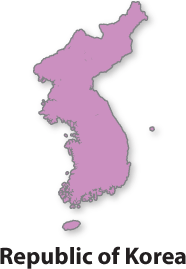Korea Biofuels Activities

Here you'll find information about Korea's work in biofuels. Learn more about its:
Background
Korea is interested in adding biofuels to its energy matrix, driven primarily by the desire to reduce air pollution and oil dependency. Biodiesel is the primary choice given the fact that Korea consumes large amounts of diesel (twice the amount of gasoline) and it has the option of producing feedstock domestically.
Production
Biodiesel production in Korea was 50 million liters in 2006. There are 15 operating biodiesel plants with a total capacity of 625 million liters/year.
There is no fuel ethanol production in Korea. Only a small amount of ethanol is produced by Changhae Ethanol Co. Ltd as a test.
Feedstock
Nearly 70%-80% of biodiesel in Korea is produced from imported soybean oil and 20%-30% from used cooking oil. Several biodiesel plants have the capability of using palm oil (USDA 2007). Due to rising soybean and palm oil prices, biodiesel producers are considering alternative feedstock such as jatropha oil, produced in the Southeast Asia region, the Philippines and Thailand for example.
Options for producing biodiesel feedstock domestically are currently explored in Korea. It is estimated that 300,000–500,000 ha of coastal land could be available for winter canola with potential output of 450,000–750,000 tonnes of canola oil per year. Three demonstration sites in the Southern part of Korea have been selected for cultivation (KIER, 2007).
Economics
The following charts show specific economic statistics for the member economy.
| Biodiesel | US$/liter |
|---|---|
| From used cooking oil | 0.90 |
| From rapeseed | 0.53 (with subsidy) – 1.37 |
| From soybeans | 1.06 |
Source: KEEI, November 2007
Biofuels in Use
B5 (5% biodiesel and 95% petroleum diesel) and B20 (20% biodiesel and 80% petroleum diesel) are available nationwide.
Infrastructure and Vehicles
Korea has supplied B5 through all of its gas stations since July 2006. There are about 200 stations offering B20 operating for fleets only. Korea also is testing E3 (3% ethanol and 97% gasoline) and E5 (5% ethanol and 95% gasoline) stations.
Trade
Korea imports soybean oil mainly from Argentina (86%) and the United States (14%). The domestic soybean oil industry estimated that of the 260,000 tonnes of soy oil imported in 2006, less than 25% was used for biodiesel production. Korea may import 1 million tonnes of soybeans by September 2008, the U.S. Department of Agriculture forecasted recently.
Policy
The government of Korea supports the development of biofuels and it aims to develop energy policy that considers both economic growth and environmental protection.
The Ministry of the Environment (MOE) began testing biodiesel and biodiesel fuel blends in early 2002. As a result of these emission tests, MOE recommended biodiesel as a renewable fuel to the Ministry of Commerce, Industry and Energy (MOCIE). MOCIE is responsible for setting standards for petroleum and petroleum substitutes, and MOE is responsible for regulating air pollution. In late 2002, 73 gas stations in the Seoul metropolitan area and Chonbuk Province were designated as demonstration stations and began carrying B20. By January 2006, the number of stations testing B20 reached 200. In 2003, Korea began preparing official biodiesel standards, and the biodiesel demonstration was extended to June 2006. The final standards, drafted in September 2004 by MOCIE, were adopted in January 2006 and are very similar to EN14214, the European biodiesel standards (USDA 2007).
Korea plans to mandate nationwide B3 by 2012 and will extend the current tax incentives on production of biodiesel to 2010.
Sources
- Korea Energy Economics Institute (KEEI)
- Bioenergy Research Center, Korea Institute of Energy Research (KIER), 2007
- U.S. Department of Agriculture, GAIN Report, 2007 (PDF 33 KB) Download Adobe Reader.